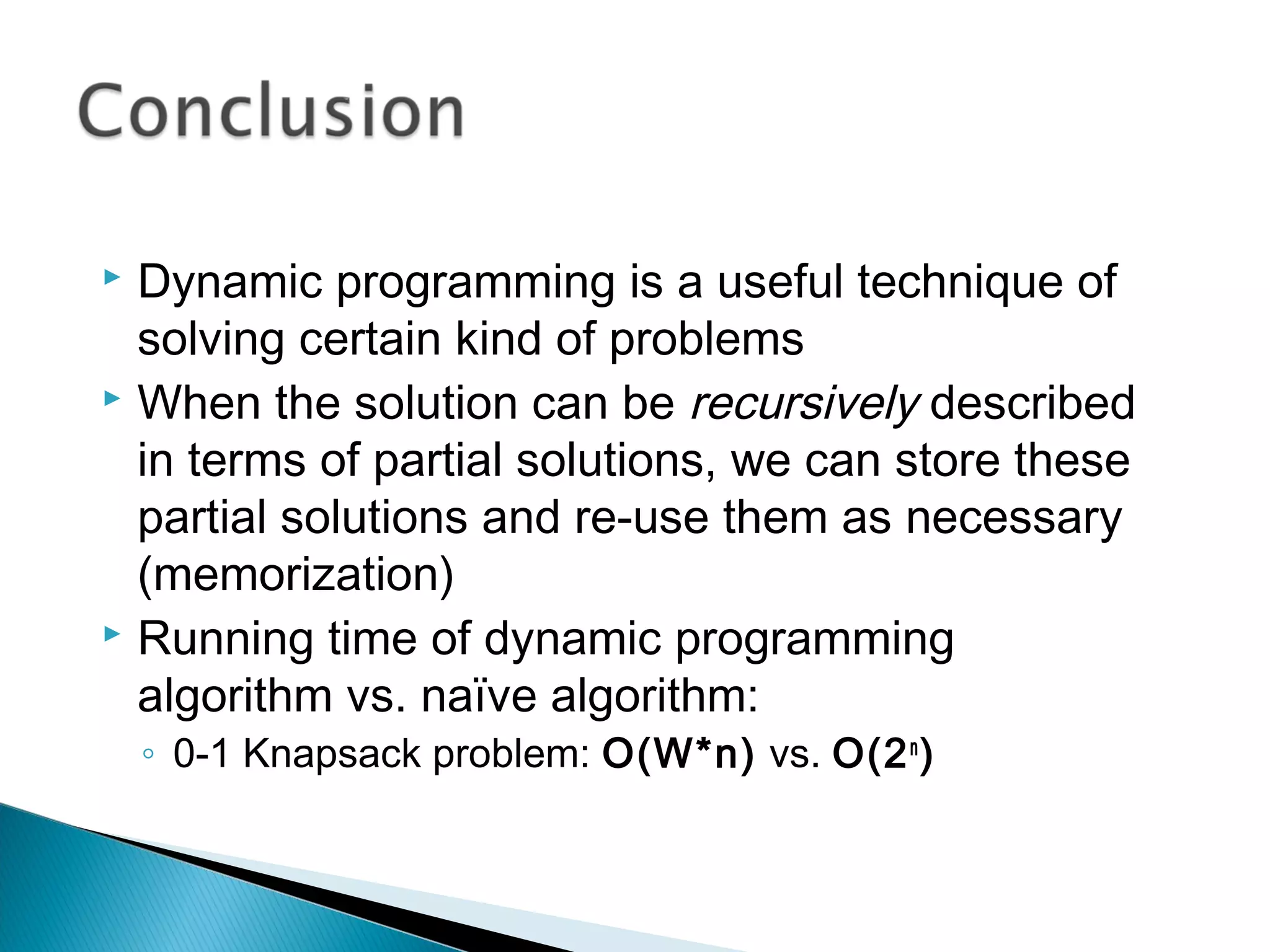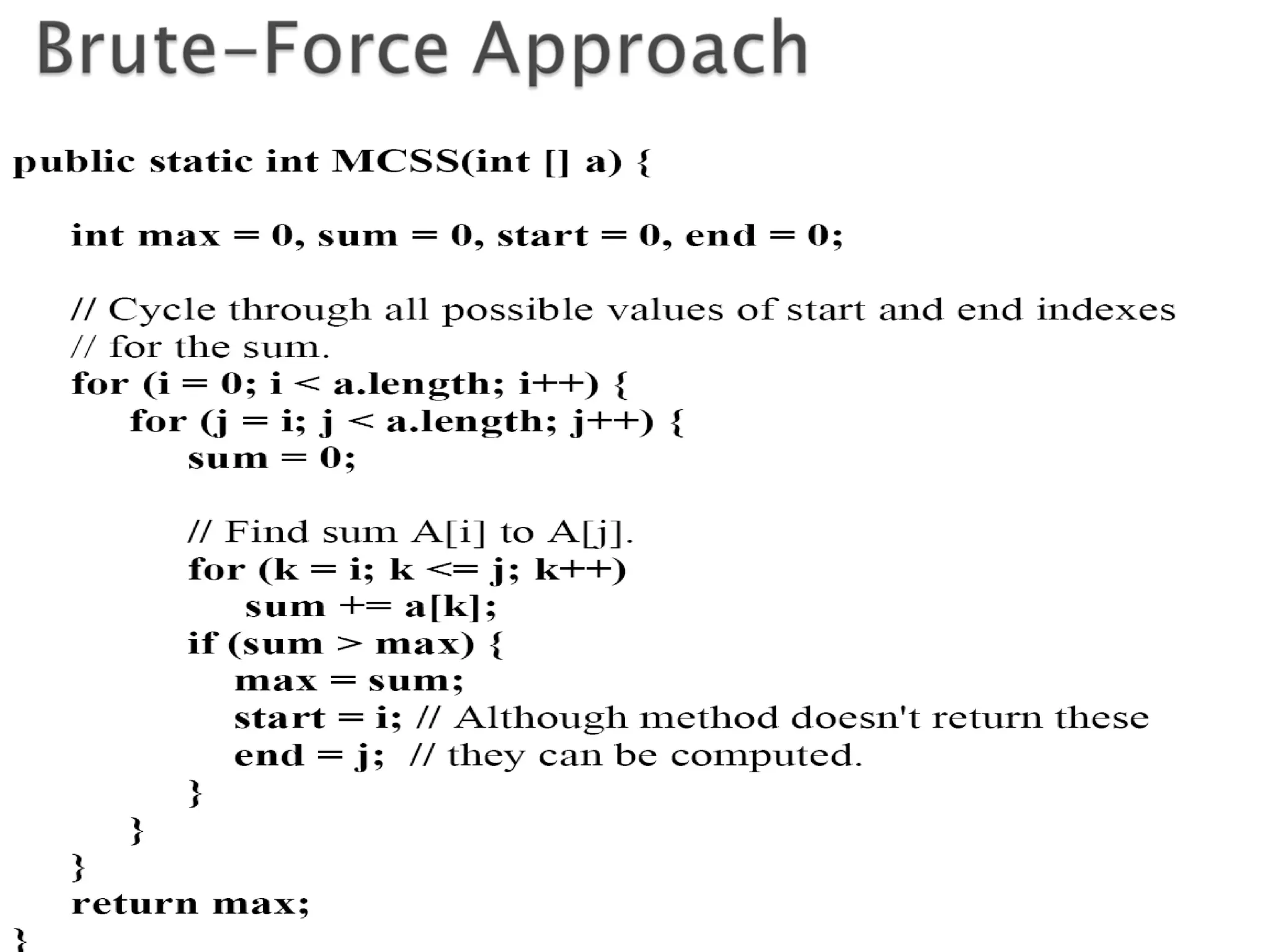The document discusses the knapsack problem, which involves selecting items to maximize total value without exceeding a weight limit. It explains two versions of the problem: the 0-1 knapsack where items cannot be divided, and the fractional knapsack where items can be divided. The solution through dynamic programming is presented, detailing the algorithm's efficiency compared to a brute-force approach.
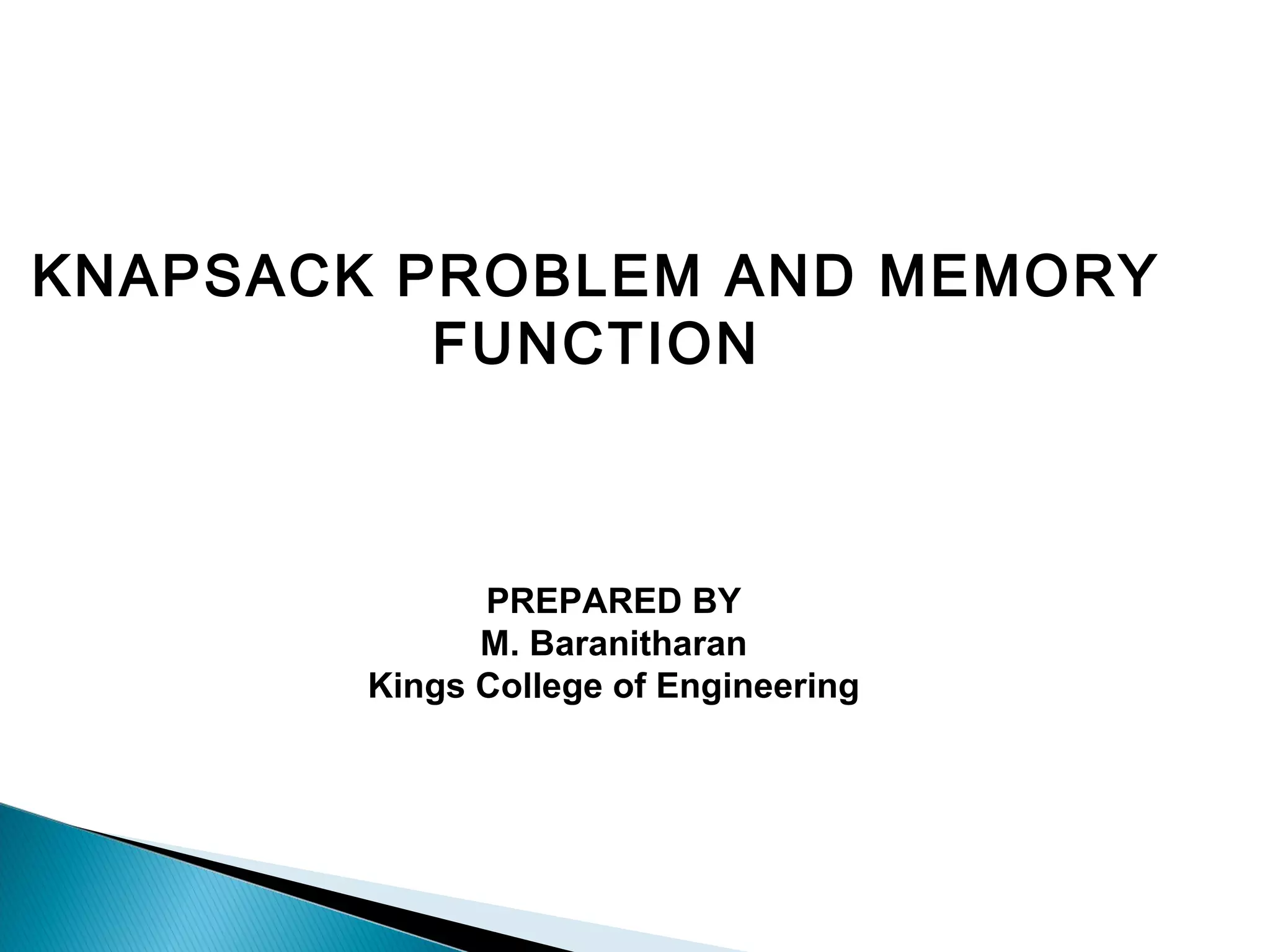
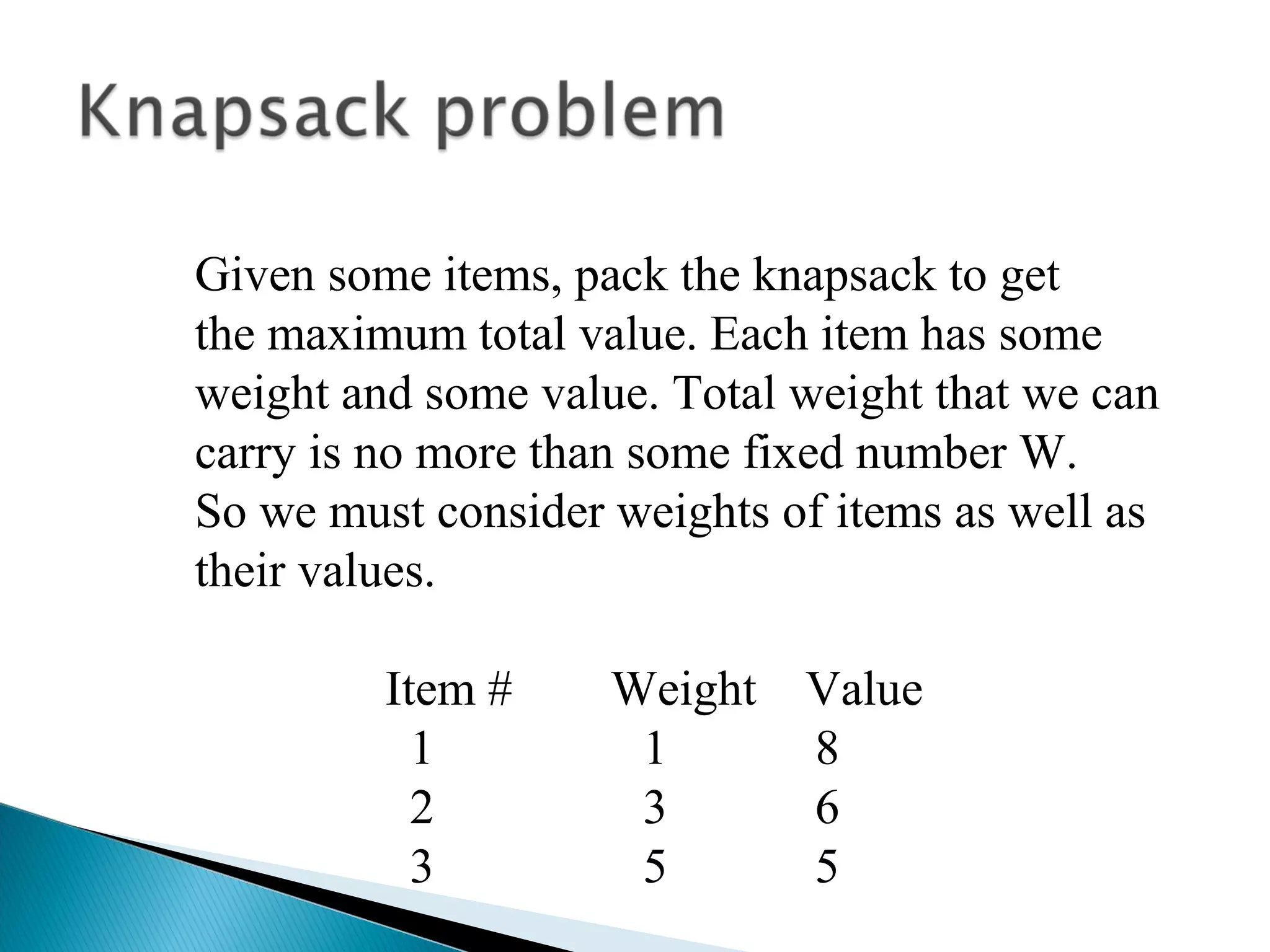
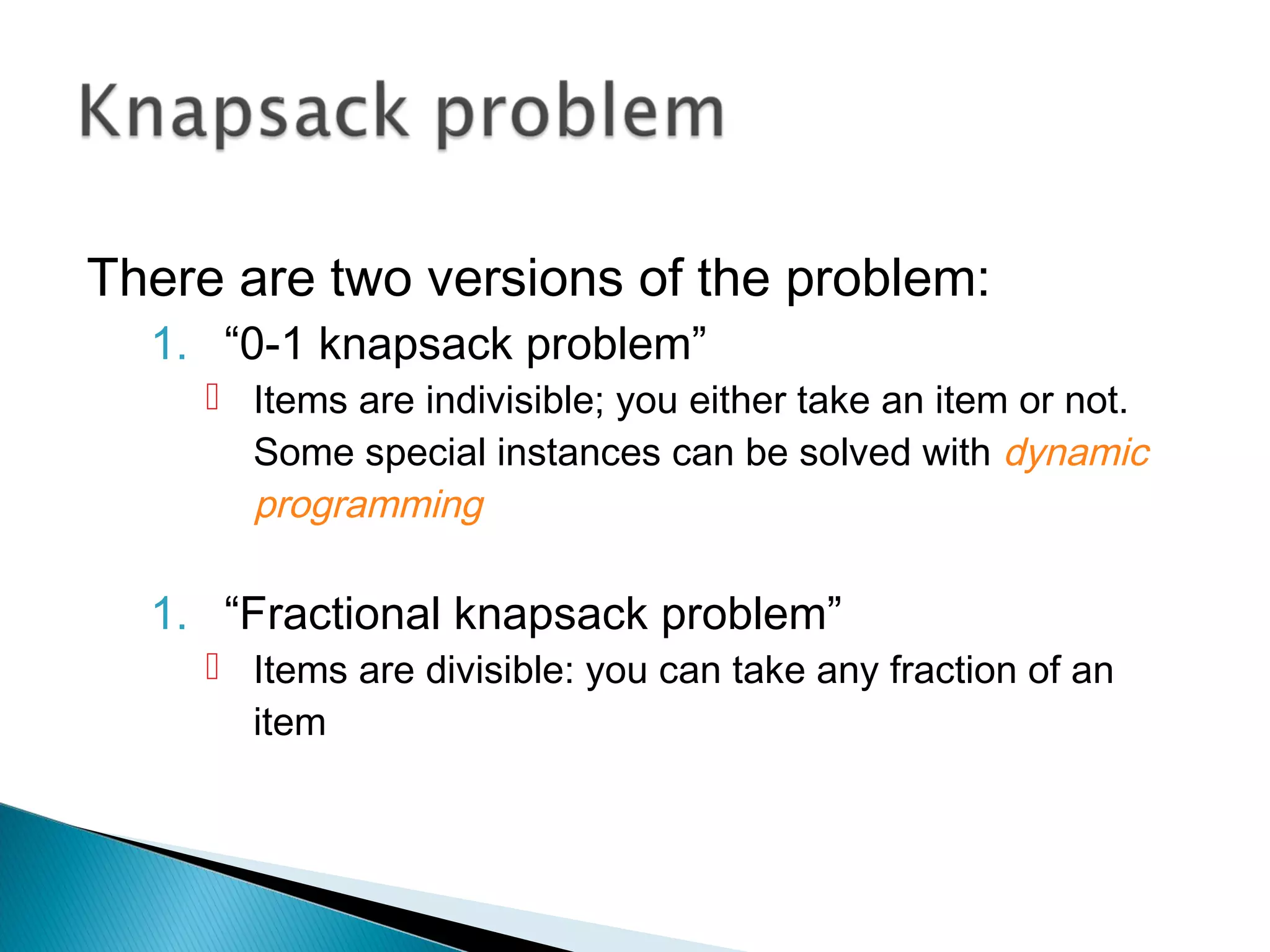
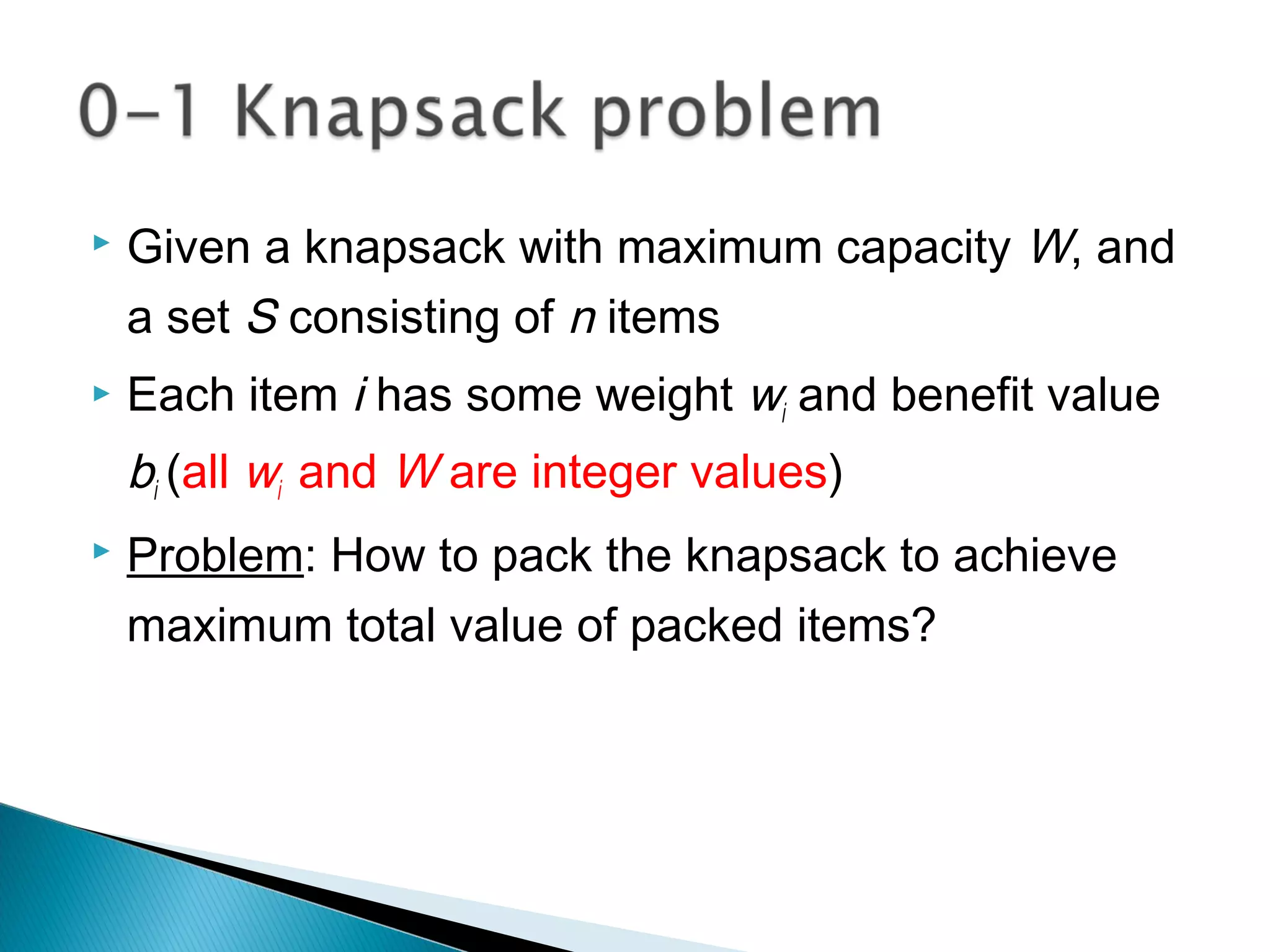
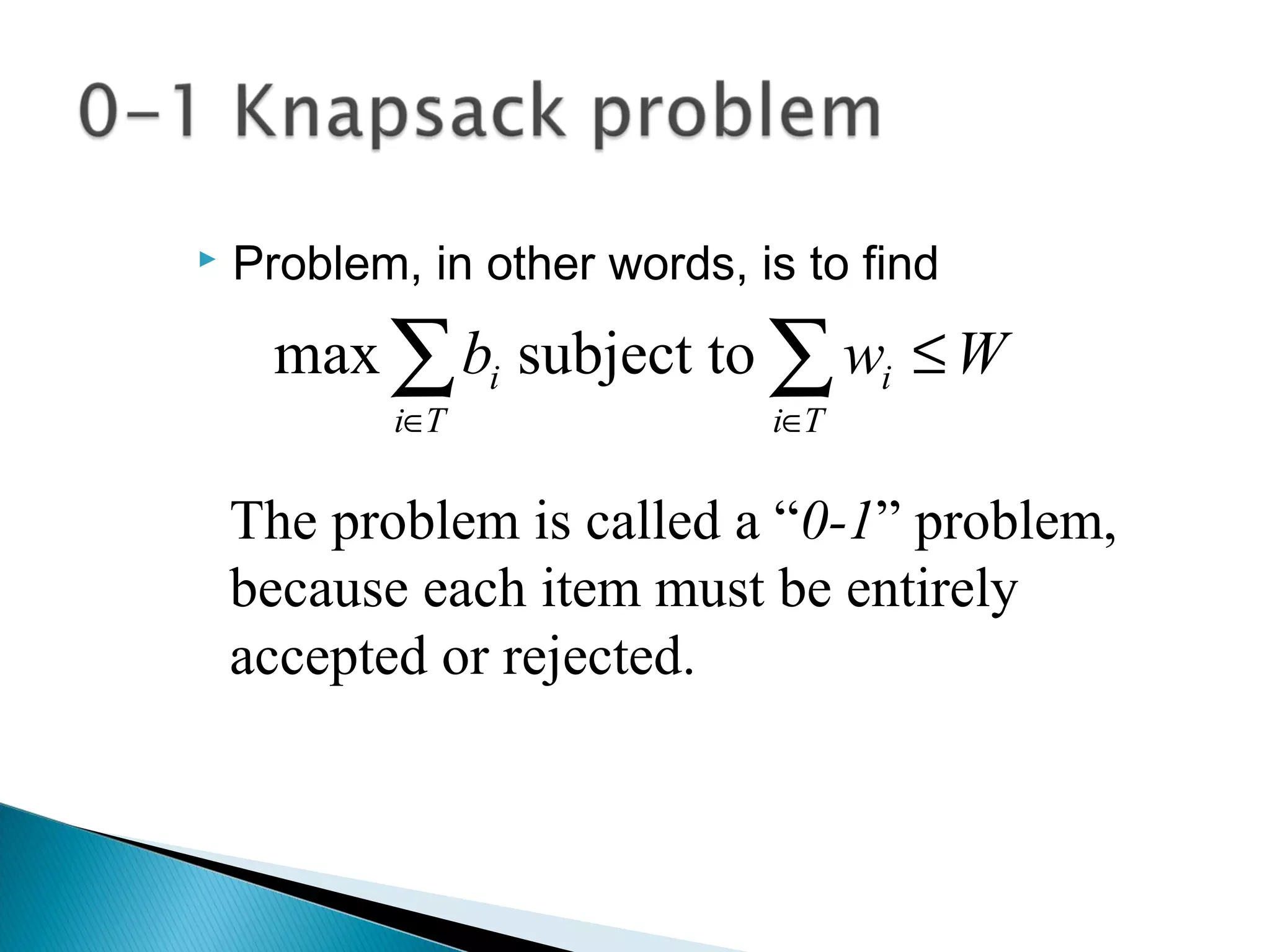
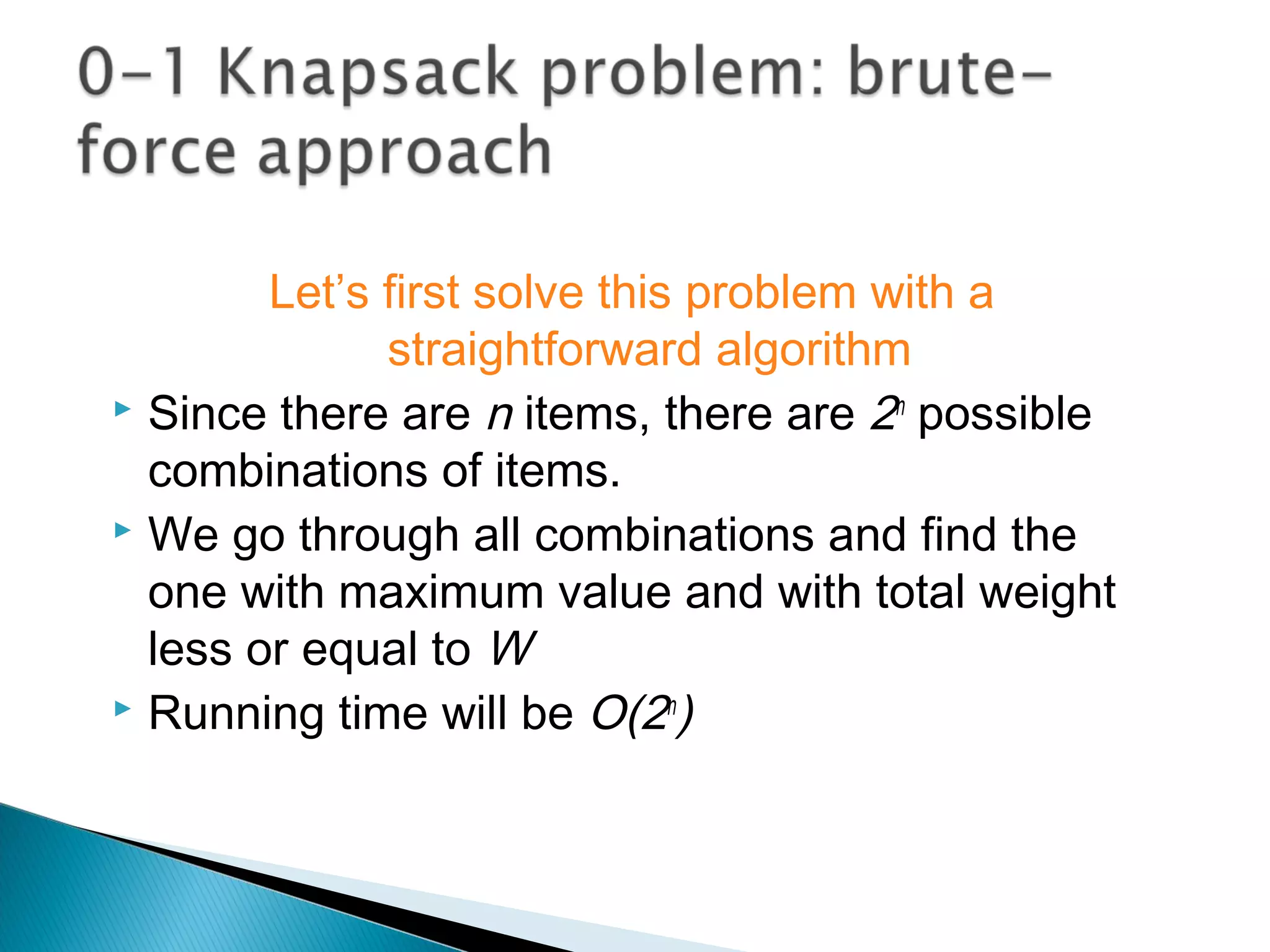
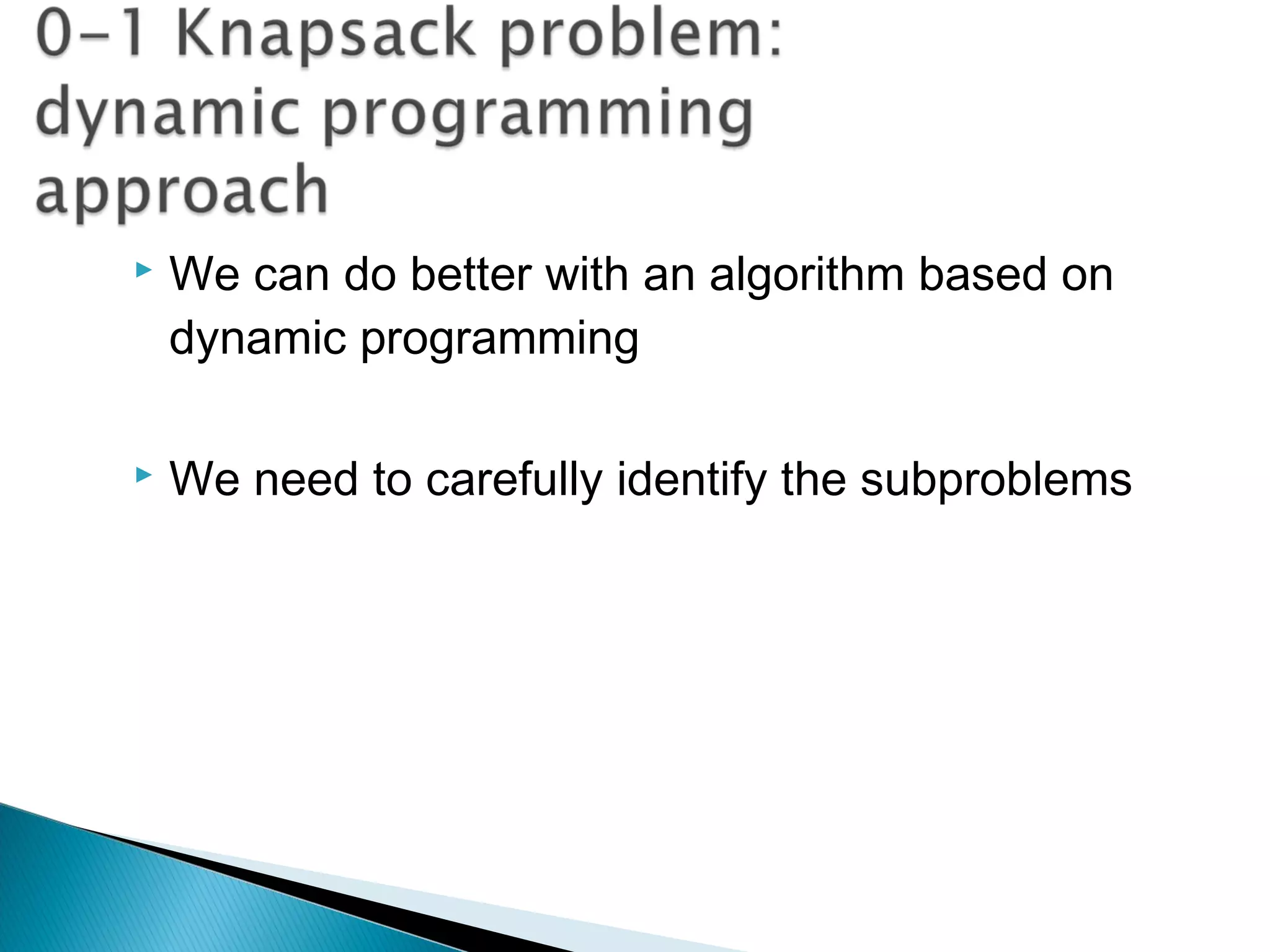
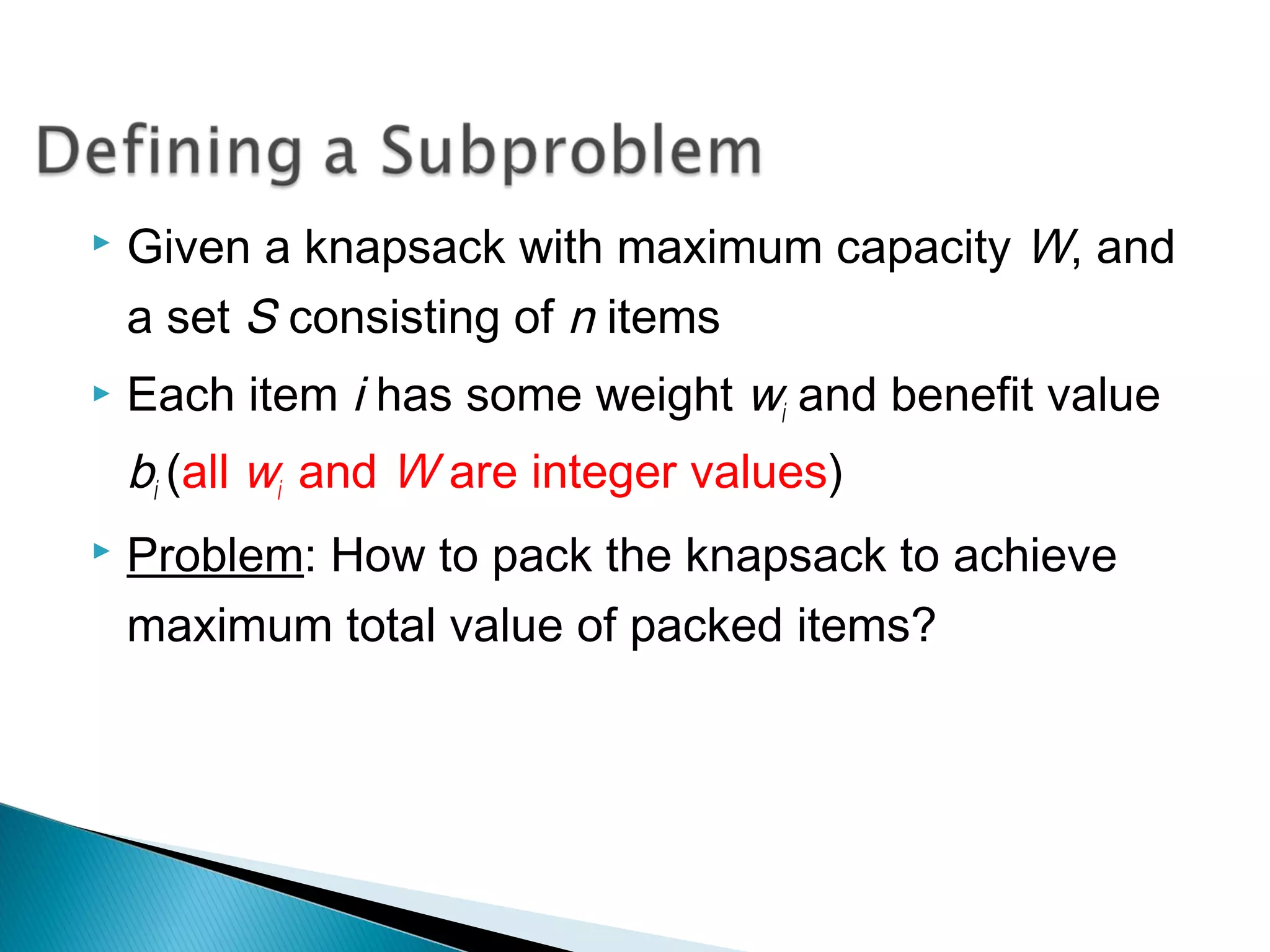
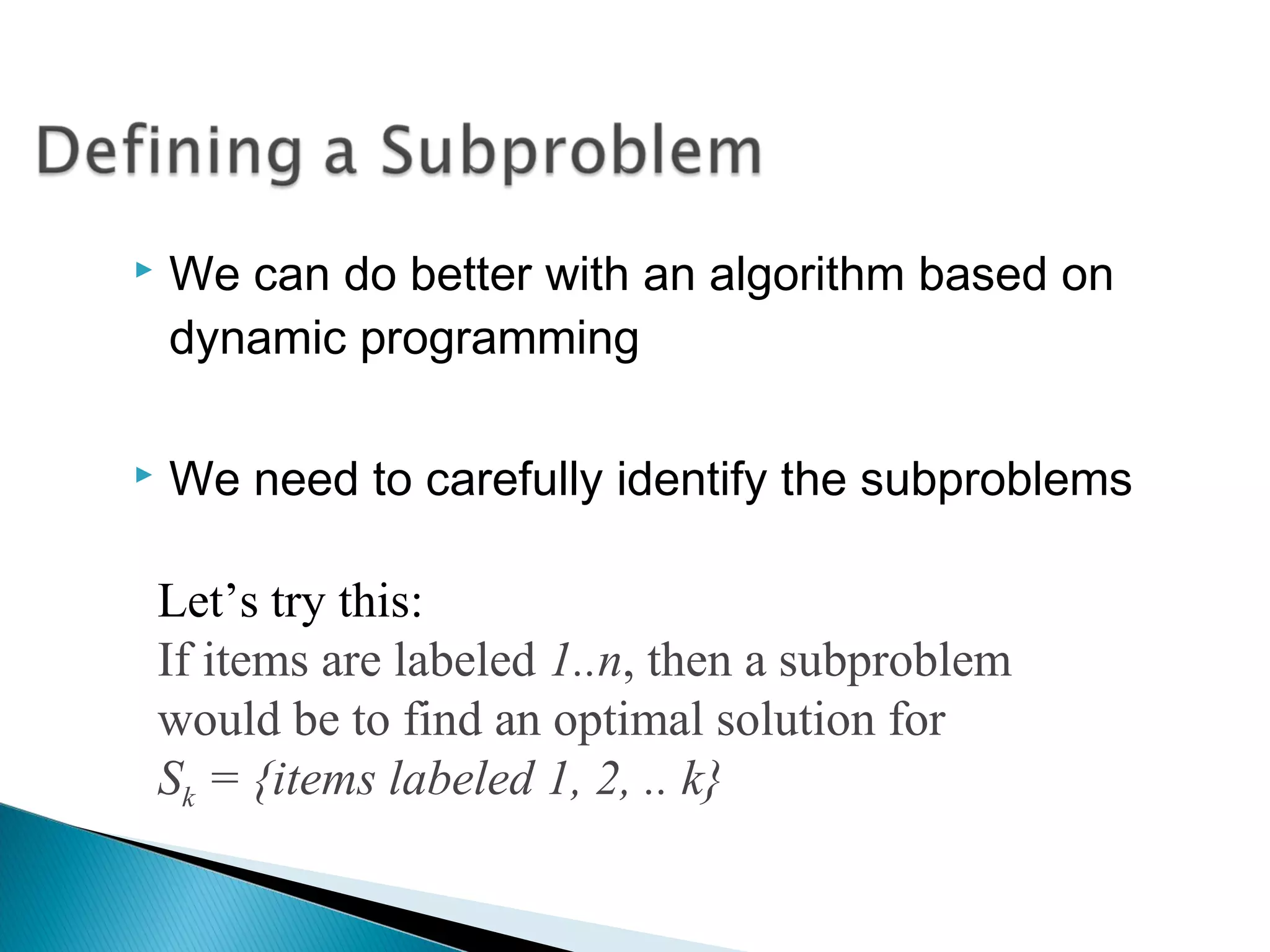
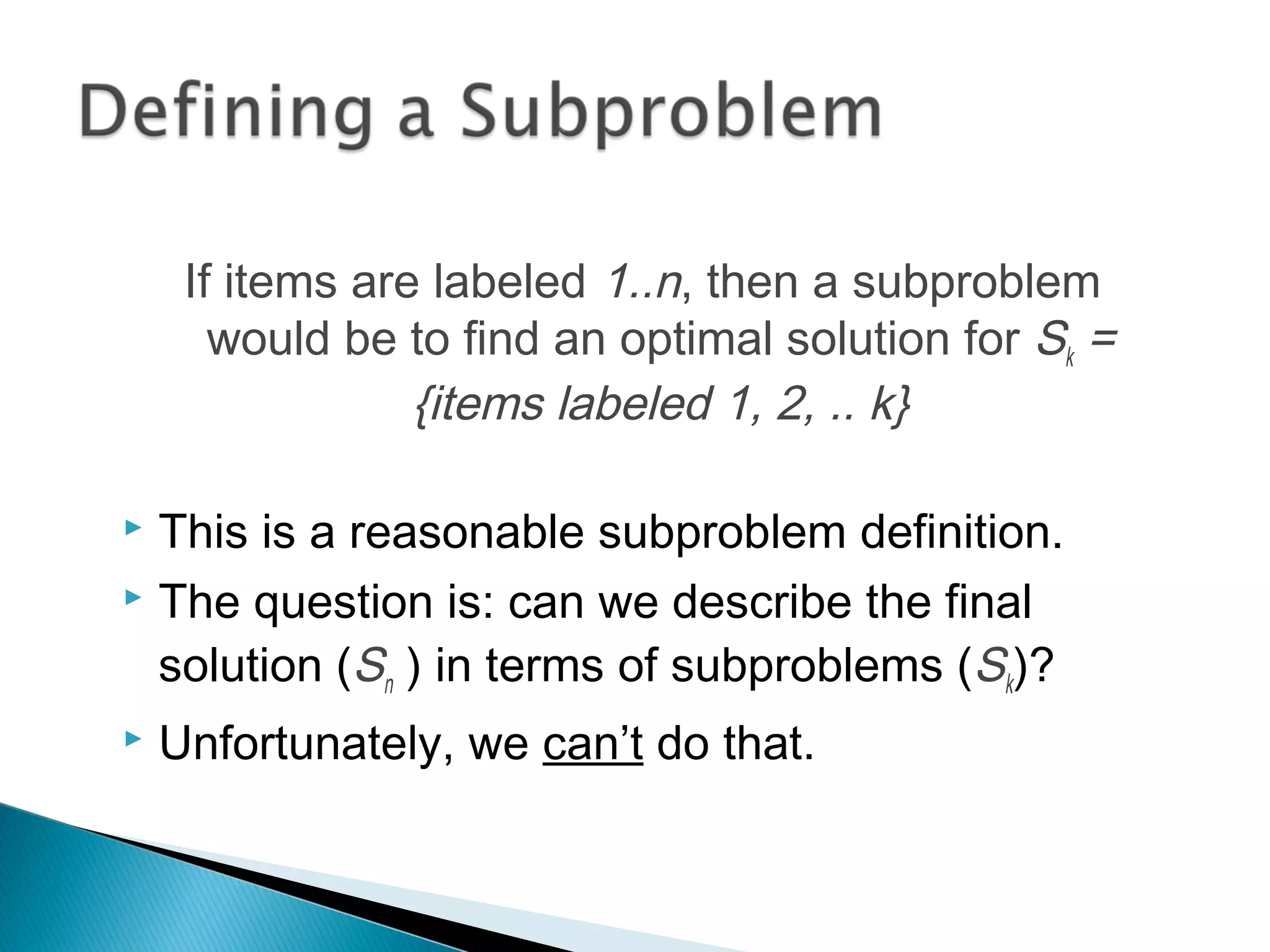
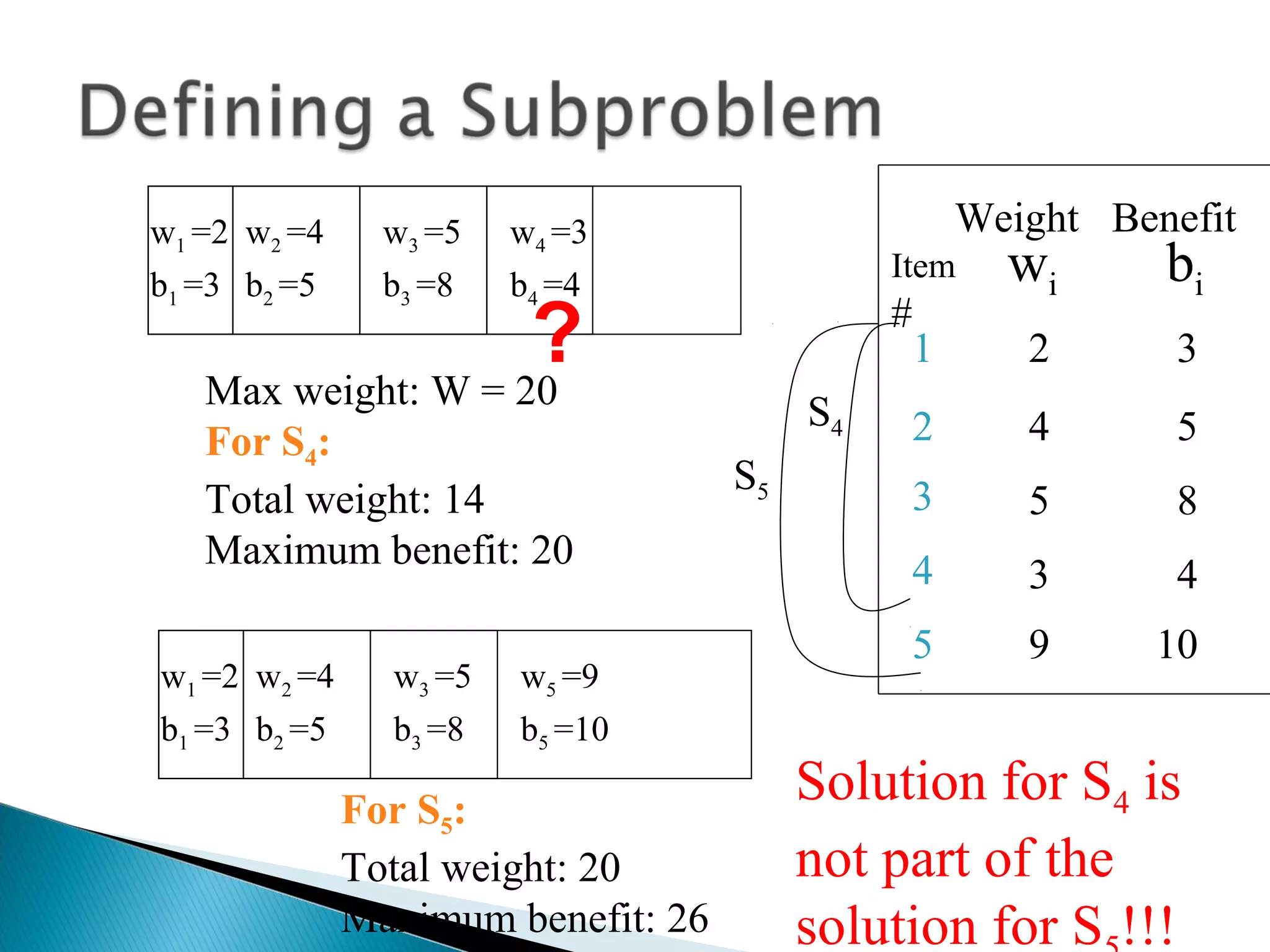
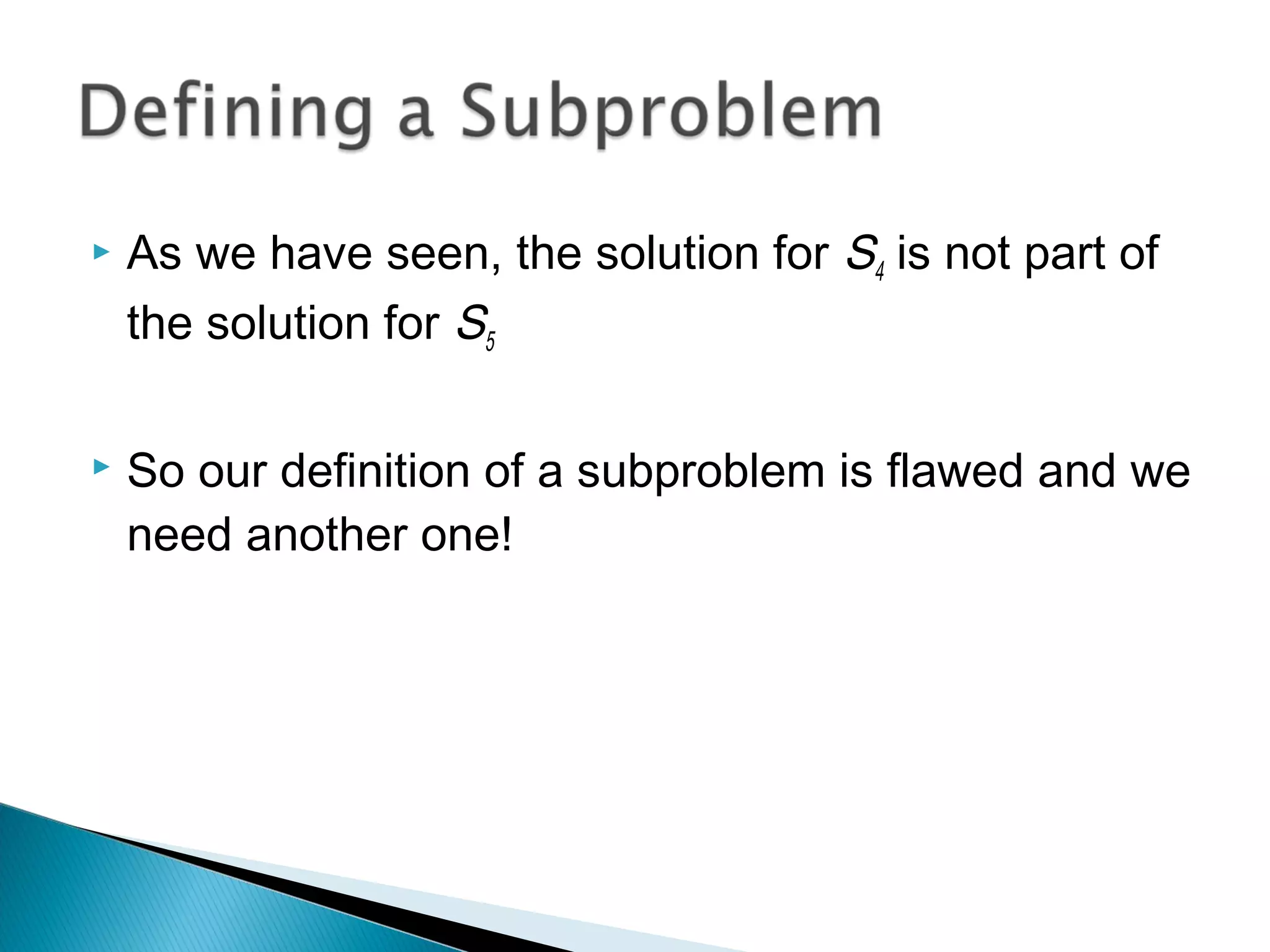
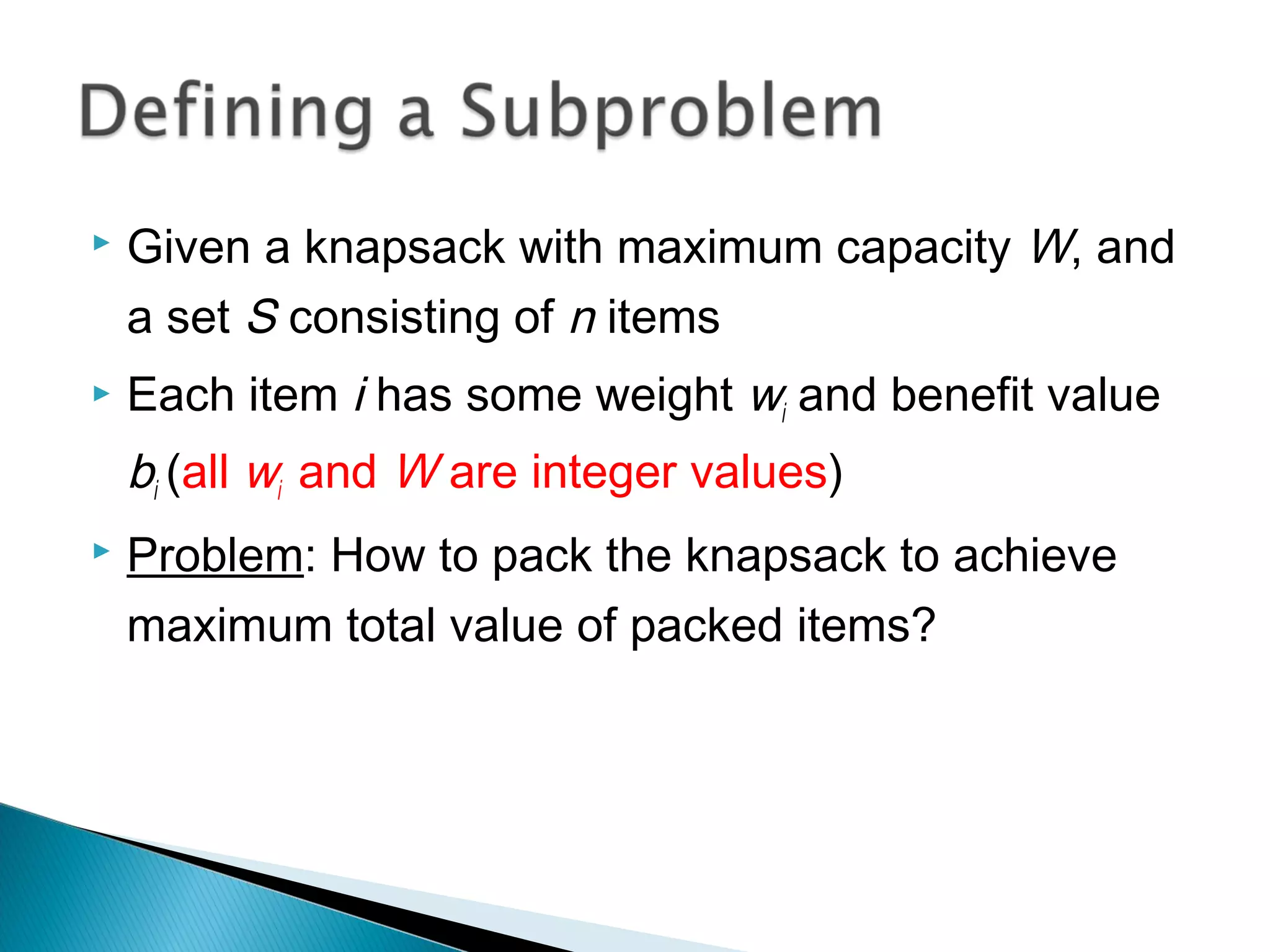
![ Let’s add another parameter: w, which will
represent the maximum weight for each subset of
items
The subproblem then will be to compute V[k,w],
i.e., to find an optimal solution for Sk = {items
labeled 1, 2, .. k} in a knapsack of size w](https://image.slidesharecdn.com/knapsackproblem-161113104612/75/Knapsack-problem-and-Memory-Function-14-2048.jpg)
![ The subproblem will then be to compute V[k,w],
i.e., to find an optimal solution for Sk = {items
labeled 1, 2, .. k} in a knapsack of size w
Assuming knowing V[i, j], where i=0,1, 2, … k-1,
j=0,1,2, …w, how to derive V[k,w]?](https://image.slidesharecdn.com/knapsackproblem-161113104612/75/Knapsack-problem-and-Memory-Function-15-2048.jpg)
![It means, that the best subset of Sk that has total
weight w is:
1) the best subset of Sk-1 that has total weight ≤ w, or
2) the best subset of Sk-1 that has total weight ≤ w-wk plus
the item k
+−−−
>−
=
else}],1[],,1[max{
if],1[
],[
kk
k
bwwkVwkV
wwwkV
wkV
Recursive formula for subproblems:](https://image.slidesharecdn.com/knapsackproblem-161113104612/75/Knapsack-problem-and-Memory-Function-16-2048.jpg)
![ The best subset of Sk that has the total weight ≤ w,
either contains item k or not.
First case: wk>w. Item k can’t be part of the solution,
since if it was, the total weight would be > w, which is
unacceptable.
Second case: wk ≤ w. Then the item k can be in the
solution, and we choose the case with greater value.
+−−−
>−
=
else}],1[],,1[max{
if],1[
],[
kk
k
bwwkVwkV
wwwkV
wkV](https://image.slidesharecdn.com/knapsackproblem-161113104612/75/Knapsack-problem-and-Memory-Function-17-2048.jpg)
![for w = 0 to W
V[0,w] = 0
for i = 1 to n
V[i,0] = 0
for i = 1 to n
for w = 0 to W
if wi <= w // item i can be part of the solution
if bi + V[i-1,w-wi] > V[i-1,w]
V[i,w] = bi + V[i-1,w- wi]
else
V[i,w] = V[i-1,w]
else V[i,w] = V[i-1,w] // wi > w](https://image.slidesharecdn.com/knapsackproblem-161113104612/75/Knapsack-problem-and-Memory-Function-18-2048.jpg)
![for w = 0 to W
V[0,w] = 0
for i = 1 to n
V[i,0] = 0
for i = 1 to n
for w = 0 to W
< the rest of the code >
What is the running time of this
algorithm?
O(W)
O(W)
Repeat n times
O(n*W)
Remember that the brute-force algorithm
takes O(2n
)](https://image.slidesharecdn.com/knapsackproblem-161113104612/75/Knapsack-problem-and-Memory-Function-19-2048.jpg)
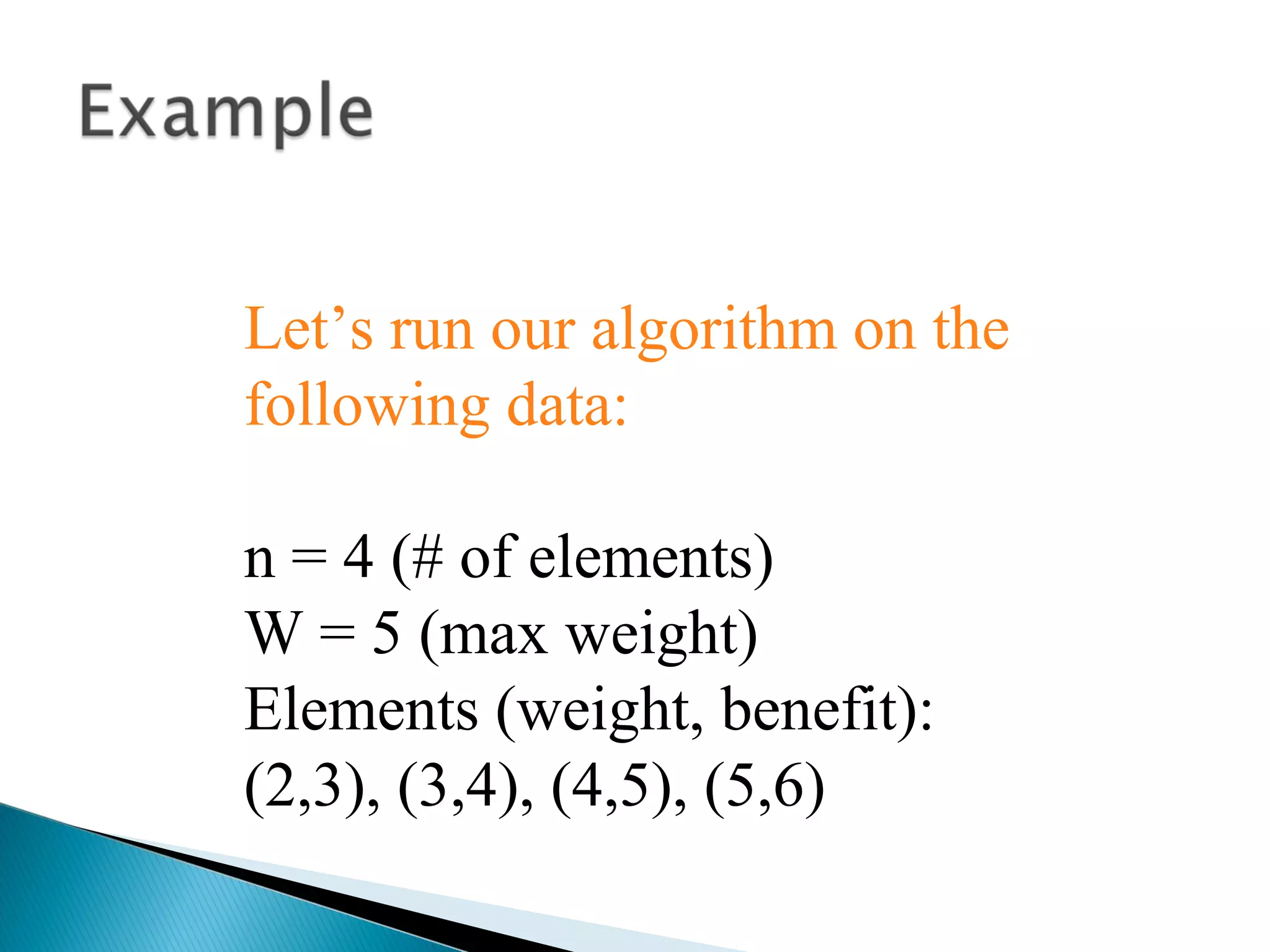
![for w = 0 to W
V[0,w] = 0
0 0 0 0 000
1
2
3
4 50 1 2 3
4
iW](https://image.slidesharecdn.com/knapsackproblem-161113104612/75/Knapsack-problem-and-Memory-Function-21-2048.jpg)
![for i = 1 to n
V[i,0] = 0
0
0
0
0
0 0 0 0 000
1
2
3
4 50 1 2 3
4
iW](https://image.slidesharecdn.com/knapsackproblem-161113104612/75/Knapsack-problem-and-Memory-Function-22-2048.jpg)
![if wi <= w // item i can be part of the solution
if bi + V[i-1,w-wi] > V[i-1,w]
V[i,w] = bi + V[i-1,w- wi]
else
V[i,w] = V[i-1,w]
else V[i,w] = V[i-1,w] // wi > w
0
Items:
1: (2,3)
2: (3,4)
3: (4,5)
4: (5,6)
0
i=1
bi=3
wi=2
w=1
w-wi =-1
0 0 0 0 000
1
2
3
4 50 1 2 3
4
iW
0
0
0](https://image.slidesharecdn.com/knapsackproblem-161113104612/75/Knapsack-problem-and-Memory-Function-23-2048.jpg)
![Items:
1: (2,3)
2: (3,4)
3: (4,5)
4: (5,6)
300
0
0
0
0 0 0 0 000
1
2
3
4 50 1 2 3
4
iW
i=1
bi=3
wi=2
w=4
w-wi =2
if wi <= w // item i can be part of the solution
if bi + V[i-1,w-wi] > V[i-1,w]
V[i,w] = bi + V[i-1,w- wi]
else
V[i,w] = V[i-1,w]
else V[i,w] = V[i-1,w] // wi > w
3 3](https://image.slidesharecdn.com/knapsackproblem-161113104612/75/Knapsack-problem-and-Memory-Function-24-2048.jpg)
![Items:
1: (2,3)
2: (3,4)
3: (4,5)
4: (5,6)
300
0
0
0
0 0 0 0 000
1
2
3
4 50 1 2 3
4
iW
i=1
bi=3
wi=2
w=5
w-wi =3
if wi <= w // item i can be part of the solution
if bi + V[i-1,w-wi] > V[i-1,w]
V[i,w] = bi + V[i-1,w- wi]
else
V[i,w] = V[i-1,w]
else V[i,w] = V[i-1,w] // wi > w
3 3 3](https://image.slidesharecdn.com/knapsackproblem-161113104612/75/Knapsack-problem-and-Memory-Function-25-2048.jpg)
![Items:
1: (2,3)
2: (3,4)
3: (4,5)
4: (5,6)
00
0
0
0
0 0 0 0 000
1
2
3
4 50 1 2 3
4
iW
i=2
bi=4
wi=3
w=2
w-wi =-1
3 3 3 3
3
if wi <= w // item i can be part of the solution
if bi + V[i-1,w-wi] > V[i-1,w]
V[i,w] = bi + V[i-1,w- wi]
else
V[i,w] = V[i-1,w]
else V[i,w] = V[i-1,w] // wi > w
0](https://image.slidesharecdn.com/knapsackproblem-161113104612/75/Knapsack-problem-and-Memory-Function-26-2048.jpg)
![Items:
1: (2,3)
2: (3,4)
3: (4,5)
4: (5,6)
00
0
0
0
0 0 0 0 000
1
2
3
4 50 1 2 3
4
iW
i=2
bi=4
wi=3
w=3
w-wi =0
3 3 3 3
0
if wi <= w // item i can be part of the solution
if bi + V[i-1,w-wi] > V[i-1,w]
V[i,w] = bi + V[i-1,w- wi]
else
V[i,w] = V[i-1,w]
else V[i,w] = V[i-1,w] // wi > w
43](https://image.slidesharecdn.com/knapsackproblem-161113104612/75/Knapsack-problem-and-Memory-Function-27-2048.jpg)
![Items:
1: (2,3)
2: (3,4)
3: (4,5)
4: (5,6)
00
0
0
0
0 0 0 0 000
1
2
3
4 50 1 2 3
4
iW
i=3
bi=5
wi=4
w= 1..3
3 3 3 3
0 3 4 4
if wi <= w // item i can be part of the solution
if bi + V[i-1,w-wi] > V[i-1,w]
V[i,w] = bi + V[i-1,w- wi]
else
V[i,w] = V[i-1,w]
else V[i,w] = V[i-1,w] // wi > w
7
3 40](https://image.slidesharecdn.com/knapsackproblem-161113104612/75/Knapsack-problem-and-Memory-Function-28-2048.jpg)
![Items:
1: (2,3)
2: (3,4)
3: (4,5)
4: (5,6)
00
0
0
0
0 0 0 0 000
1
2
3
4 50 1 2 3
4
iW
i=4
bi=6
wi=5
w= 1..4
3 3 3 3
0 3 4 4
if wi <= w // item i can be part of the solution
if bi + V[i-1,w-wi] > V[i-1,w]
V[i,w] = bi + V[i-1,w- wi]
else
V[i,w] = V[i-1,w]
else V[i,w] = V[i-1,w] // wi > w
7
3 40
70 3 4 5
5](https://image.slidesharecdn.com/knapsackproblem-161113104612/75/Knapsack-problem-and-Memory-Function-29-2048.jpg)
![Items:
1: (2,3)
2: (3,4)
3: (4,5)
4: (5,6)
00
0
0
0
0 0 0 0 000
1
2
3
4 50 1 2 3
4
iW
i=4
bi=6
wi=5
w= 5
w- wi=0
3 3 3 3
0 3 4 4 7
0 3 4
if wi <= w // item i can be part of the solution
if bi + V[i-1,w-wi] > V[i-1,w]
V[i,w] = bi + V[i-1,w- wi]
else
V[i,w] = V[i-1,w]
else V[i,w] = V[i-1,w] // wi > w
5
7
7
0 3 4 5](https://image.slidesharecdn.com/knapsackproblem-161113104612/75/Knapsack-problem-and-Memory-Function-30-2048.jpg)
![ This algorithm only finds the max possible value
that can be carried in the knapsack
◦ i.e., the value in V[n,W]
To know the items that make this maximum value,
an addition to this algorithm is necessary](https://image.slidesharecdn.com/knapsackproblem-161113104612/75/Knapsack-problem-and-Memory-Function-31-2048.jpg)
![ All of the information we need is in the table.
V[n,W] is the maximal value of items that can be
placed in the Knapsack.
Let i=n and k=W
if V[i,k] ≠ V[i−1,k] then
mark the ith
item as in the knapsack
i = i−1, k = k-wi
else
i = i−1 // Assume the ith
item is not in the knapsack
// Could it be in the optimally packed
knapsack?](https://image.slidesharecdn.com/knapsackproblem-161113104612/75/Knapsack-problem-and-Memory-Function-32-2048.jpg)
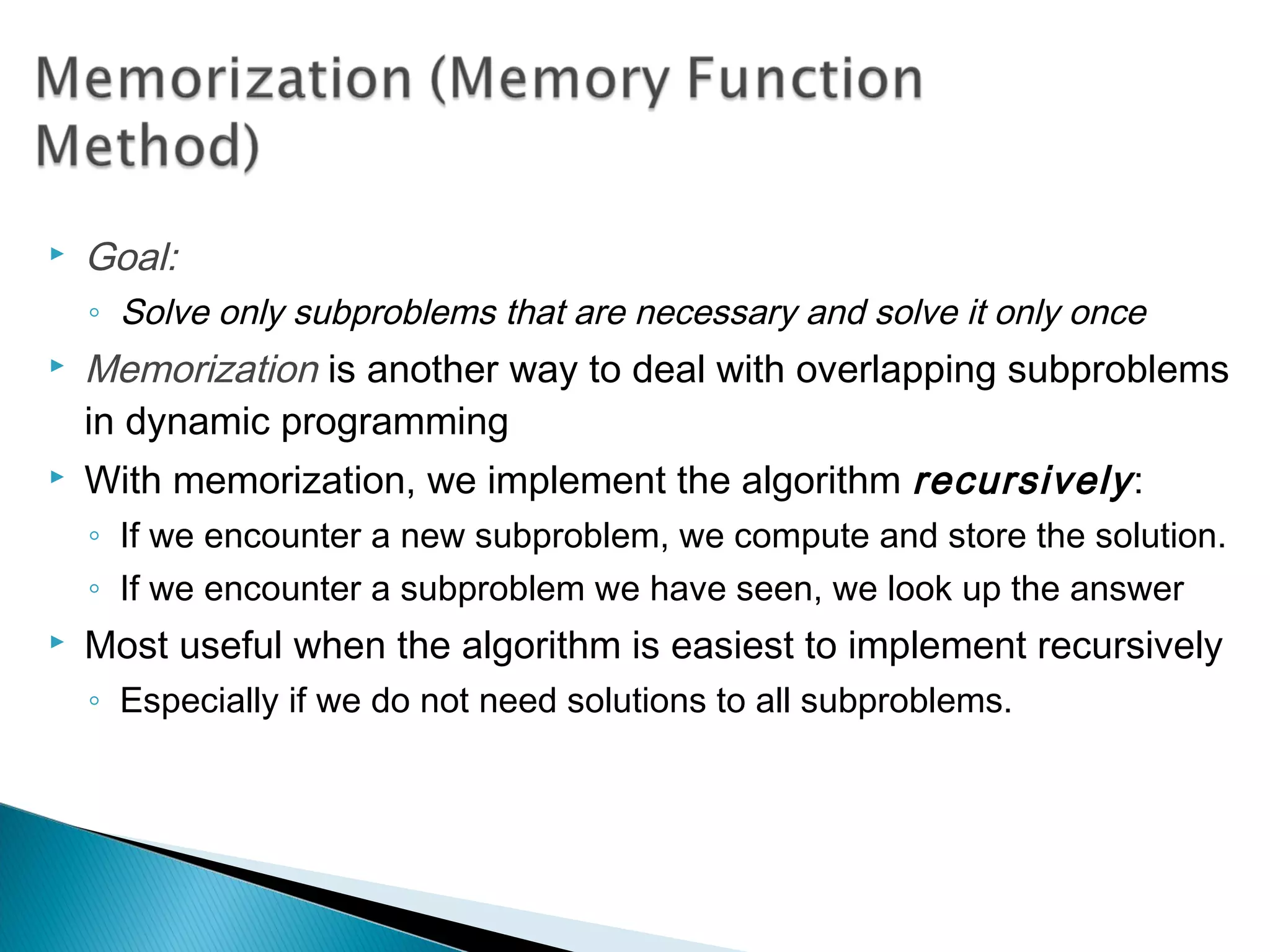
![for i = 1 to n
for w = 1 to W
V[i,w] = -1
for w = 0 to W
V[0,w] = 0
for i = 1 to n
V[i,0] = 0
MFKnapsack(i, w)
if V[i,w] < 0
if w < wi
value = MFKnapsack(i-1, w)
else
value = max(MFKnapsack(i-1, w),
bi + MFKnapsack(i-1, w-wi))
V[i,w] = value
return V[i,w]](https://image.slidesharecdn.com/knapsackproblem-161113104612/75/Knapsack-problem-and-Memory-Function-34-2048.jpg)
